Whether you know wine or not, you must know oak barrels. We often hear “This wine has been aged 3 years” and “This wine has the smell of toast and wood”. These are all about oak barrels. We also often see large wine cellars filled with oak barrels.
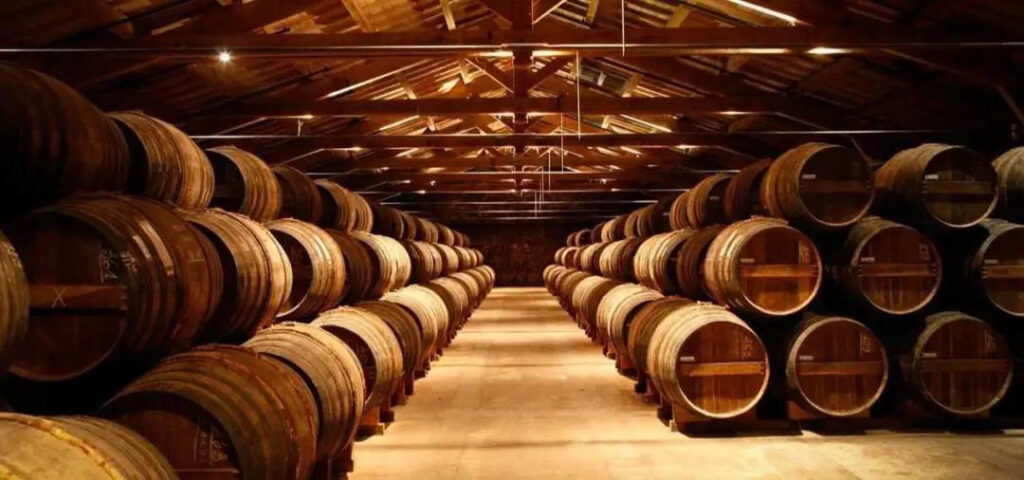
It’s as if as long as you make wine, especially high-end wine, you’re going to use oak barrels.
So, what exactly is an oak barrel?
What does it do with alcohol?
Any difference between oak barrels?
How do oak barrels come about?
How to choose an oak barrel?
Do I have to use oak barrels when making wine?
Next, let’s find out.
What is an oak barrel?
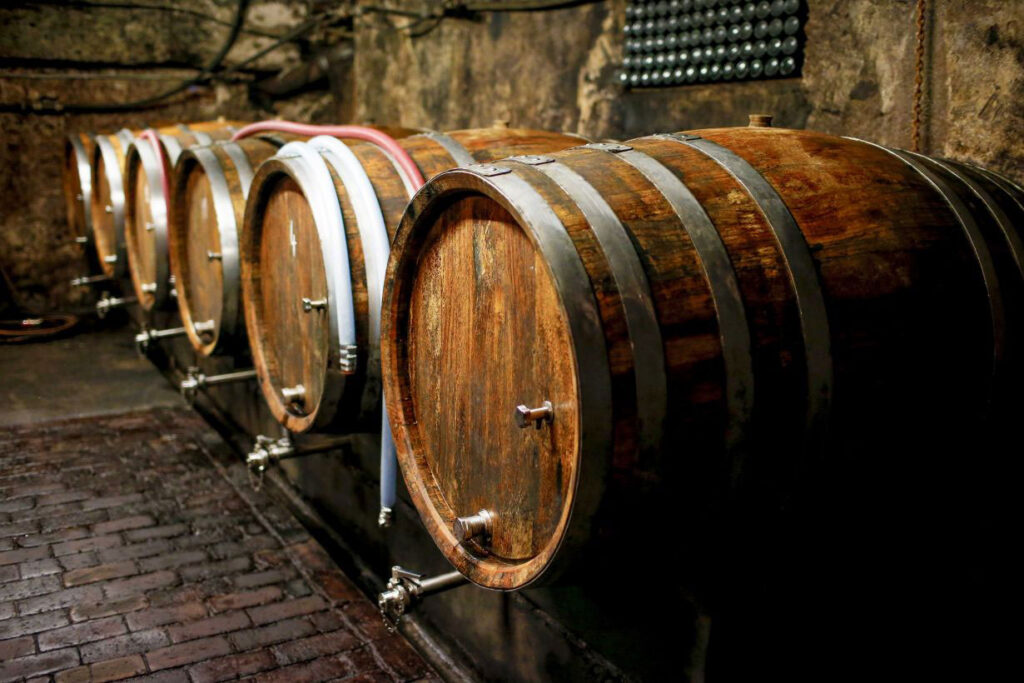
Simply put, oak barrels are barrels made of oak. Used for the storage, fermentation, and aging of wine.
At first, oak barrels did not have their current status, but only served as a container for wine. Before oak barrels, people tried many containers to hold wine for transportation. Amphora, and barrels made of palm wood. Although these materials can meet the requirements, they are not inconvenient when using.
Later, in a chance, the Romans discovered that oak might meet all their requirements. This kind of Oak can be seen everywhere in the European forest. It is very easy to bend and fashion into barrels. Second, the tight particles in the oak can play a good waterproof effect. Soon, the European continent set off a wave of oak barrels.
After a period, people were surprised to find that oak barrels can bring more pleasant flavor to the wine. The wine in the oak barrels is always more delicate and softer, and tastes better. Although people didn’t know how it worked, the tradition of using oak barrels began.
So, why is the wine in oak barrel more delicate and softer, and tastes better?
1. Fundamentally, oak has many esters, phenols and aldehydes. The oak ester has a coconut aroma. After toasting, the oak barrels impart a series of aromatic substances, but also enhance some of the oak’s less obvious aromas. such as soil, vanilla, spicy and smoky notes, bitter almonds, caramel and other flavors. Besides, if fermentation (e.g. malic acid-lactic acid fermentation) occurs in oak barrels, these oak ingredients can also interact with yeast and bacteria, to produce flavors such as leather, meat, coffee, cloves, etc. . Many of the oak flavors are passed on to the liquor, increasing the complexity of the flavor of the wine.
2. The tannins in wine mainly come from grape skins, terriers, grape seeds. And oak contains a certain number of hydrolytic tannins. During aging, it slowly penetrates into the wine, and mix with the wine tannins, making the wine body thicker. High tannins also enhance the antioxidant capacity of wine, increasing its aging potential.

3. The special organizational structure of oak makes it have a certain impermeable function and breathable function. It allows evaporation and oxygenation to occur in wine. Evaporation and oxygenation speed up the process of wine aging, soften tannins, reduce the strong spicy of high alcohol concentration. Thereby, the taste of wine becomes round and smooth.
4. While wine matured in oak barrels, the tannins and pigments in the wine combine into a macromolecule. Thereby the color of the wine changes. Dark wine aged in oak barrels becomes lighter, and vice versa.

Are oak barrels all the same? Are there any different types?
The type of oak barrel can be divided into different types according to the species of oak, the sources of the trees, the refurbished and new barrels, the degree of toasting of the barrels, the shape, size and thickness of the barrels.
- The species of oak



There are about two hundred and fifty kinds of oaks in the world. But there are only 3 kinds of oak can be used to make oak barrels because of their water-resistance. One is Quercus Alba in the United States and two others in France (Quercus Sessiliflora and Quercus Robur).
2 . The source of trees
Depending on the source, winemakers can choose between French oak and American oak. There are also many winemakers who prefer Eastern European oak from Slovenia and Hungary. However, the oak barrels produced everywhere have their own characteristics.
French oak barrels bring more detailed flavours to the wine, especially pinot noir and chardonnay, which are perfectly paired with French oak barrels.
American oak barrels are more intense, with sweet coconut, cocoa and vanilla aromas that add more complexity to many fresh, fruity new wines.
One of the important reasons why Hungarian oak barrels are becoming more popular is that they are not very different from French oak barrels. And the flavor features of the wine are similar to those of French oak barrels. But they are cheaper. In most cases, Hungarian oak barrels give the wine more nutty flavor. What is more, Vanilla and cream flavor.
3. New and old oak barrels

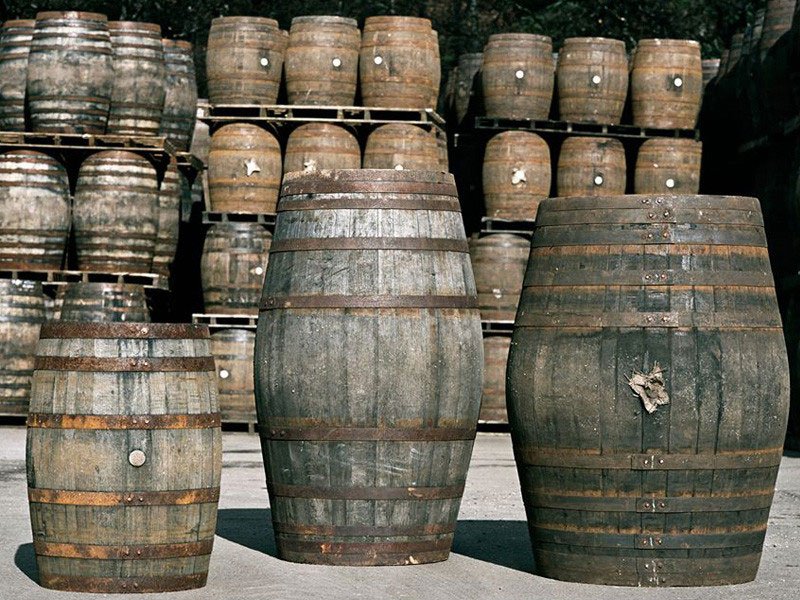
New barrel: It imparts more flavor to wine.
Old barrel: Tannins and flavor from the barrel is lighter.
The newer oak barrel is, the more flavor will be imparted into wine, the older oak barrel is, the less flavor will be in wine. After four or five times using, oak barrels give the wine little flavor.
4. Light, medium, and heavy toasting of oak barrels
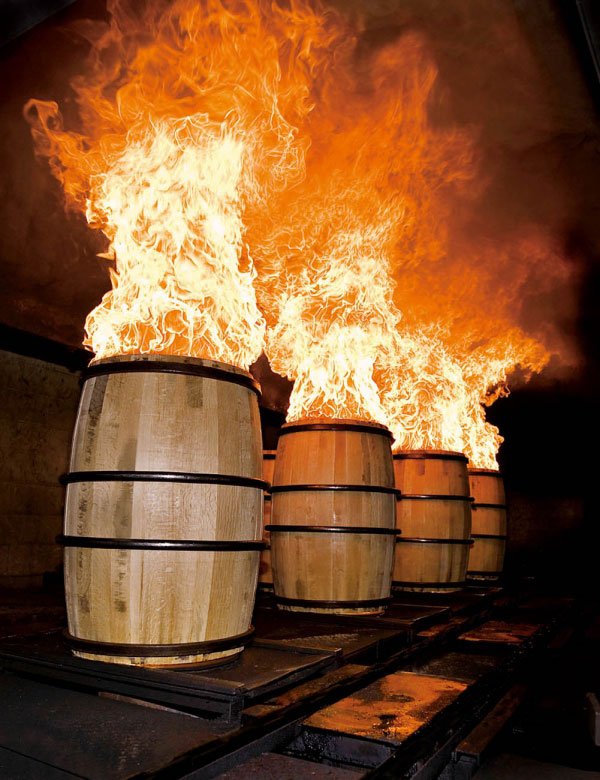
Oak barrels need to be toasted when they are made. The degree of toasting determines the “oak flavor”. As the toasting level increases, the aroma of oak barrels can range from softer aromas such as toast, honey and caramel to thicker aromas such as herbs, nuts, coffee, and smoky. The heavier the toast, the stronger and more varied the flavors are.
5. Shape, size and thickness of oak barrels

Shape: At the same capacity, the wine has a larger contact area with wood in the oval barrel(which is fairly common in Tuscany) than in a traditional round barrel. Wine matures faster in oval barrel.
Size: The most common sizes for oak barrels are 225 litres in Bordeaux and 228 litres in Burgundy. Both barrels are known as Barrique. The larger the oak barrel, the less contact the wine has with the oak, and the less affected it is by oak and oxidation. The longer time you store, the larger the oak barrel.
Wood thickness: The same oak variety, the thicker the stave, the less oxygen enters, and the slower the wine matures.
So how exactly do oak barrels come about?
1. Choose high-quality and stable forest areas. It is conducive to maintaining the aroma of oak barrels elegant style consistent.


2. Choose the trees with fewer branches, straight trunk and are more than 200 years old for felling.
3. Pick the available tree segments and mark in detail.


4. Cut the available log segments according to marks.
5. Split the logs into staves along with grain.
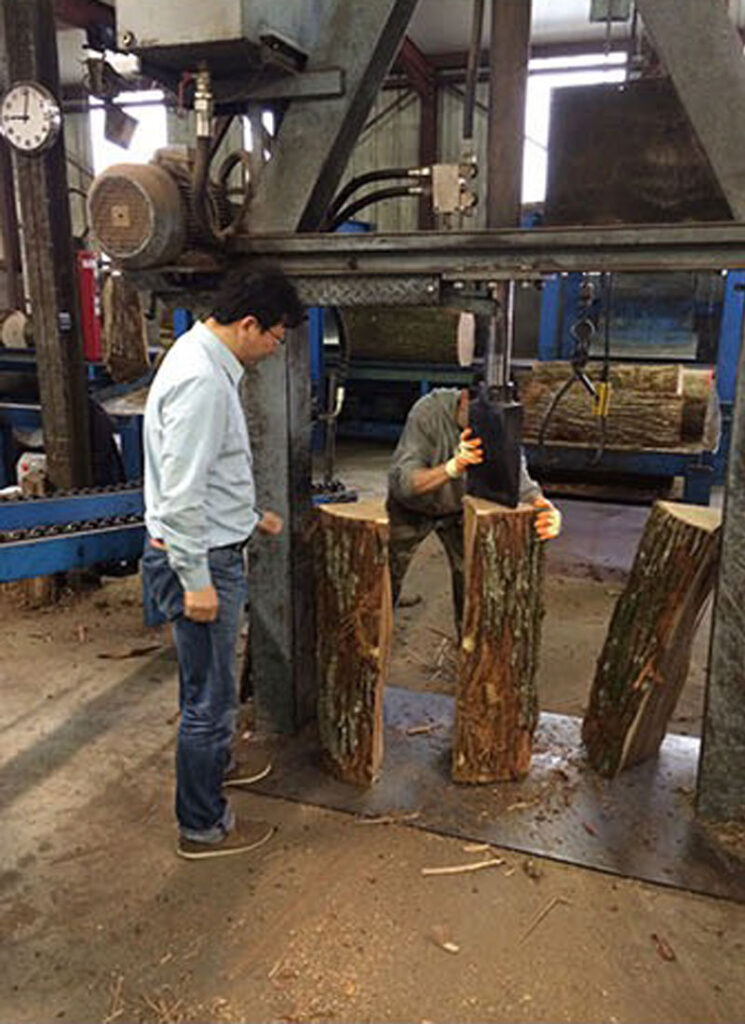


6. Process the staves into barrel boards. And dry them outdoors for 2-3 years. During this period, wood tannins are softer and more delicate.
7. After 2-3 years of drying, process the wood into oak barrel accessories. And carry out strict spot checks. Ensure that the size standard.


8. Assemble oak barrels
9. Toast



10. Analysis and inspection of the aroma characteristics of the finished barrel.
That’s how trees go to barrels. When using old barrels, it is not directly to fill them with new wine. Instead, the old barrels will have to be refurbished before they can be used.
1. Purchase Barrels with a service life of less than 2 years. This is to ensure that there is still enough high-quality aroma in the barrels.


2. Open the old barrel. Remove the old, tasteless layer of wood from the inner wall.
3. Reassemble and toast.
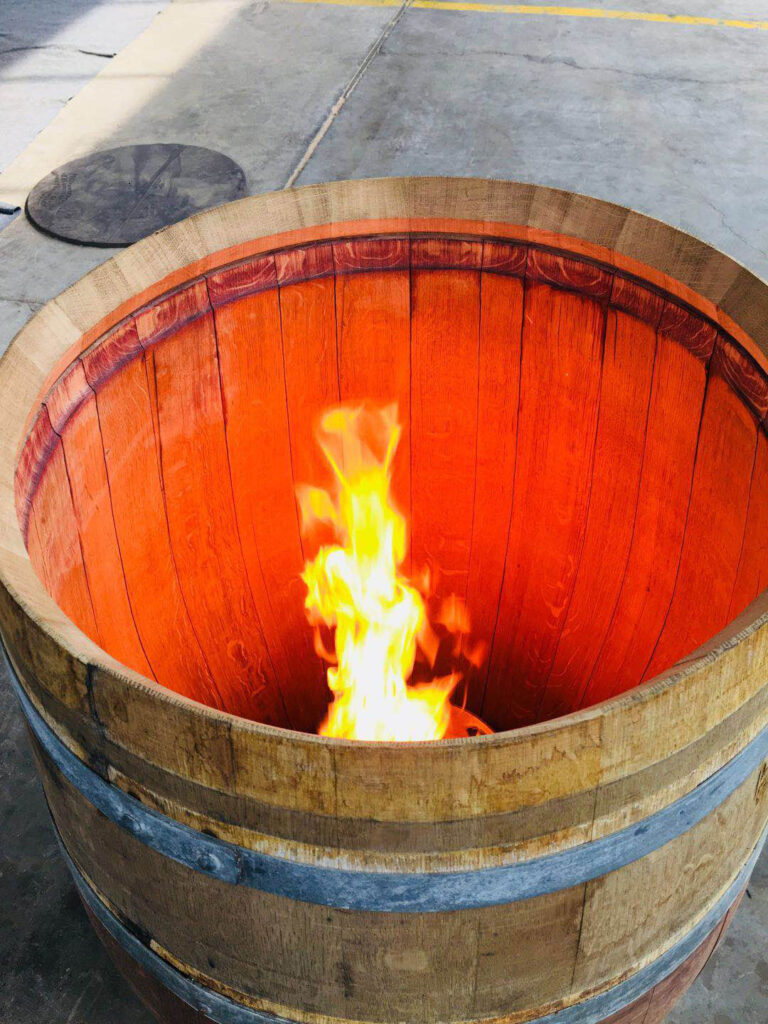


How to choose oak barrels?
Winemakers should choose oak species and tree resource based on their brand flavor and raw materials (fruit, grain).
Also, some wineries use both new and old oak barrels to get a certain wine style. Based on same grapes and same fermentation process, the proportion of new and old barrels results in different wine styles. Domaine Jacques-Frederic Mugnier uses a new barrel ratio of 10-15%. The wine is more subtle and elegant. With noticeable acidity, full of floral and sour cherry flavors, and a light toast. Domaine Comte Georges de Vogue Using a new barrel ratio of one-third. The wine is plumper and calmer. It is filled with the taste of taffy sugar. Fruity is not noticeable at first, and then slowly interwoven with oak flavors.
Whisky age in barrels which stored sherry, bourbon, rum, Barolo. This is to increase its distinctive flavor.
Of course, there are some wineries mixing old and new barrels to save money, not for quality or a certain style. New oak barrels are expensive, and one costs more than $1,200 The price of the old barrel is only about one-third of the price of the new barrel. Mixing old and new oak barrels can reduce costs.
Do I have to use oak barrels?
The answer varies from wine to wine.
The vast majority of the world’s top red wines have aged in oak barrels. Chinese Baijiu Never uses oak barrels. Some whiskeys are stored in stainless steel vessels.
Until stainless steel vessel appeared, almost all wines were aged and stored in oak barrels. Oak barrels have a long history as storage containers. Types, barrel shape, and toasting degrees are essential elements for distinguishing between different oak barrels. These elements also affect wines in oak barrels.
Oak barrels are made from a certain number of tied-up staves and then toasted. There is a small gap between staves. It provides conditions for the wine to carry out appropriate “micro-oxidation”. It is conducive to the natural maturing of wine. During this period, the wine phenolic substances and oak barrel aroma react. And eventually, the aroma of the wine is richer.
At present, most traditional wineries still insist on the use of oak barrels. Although many wineries today choose stainless steel vessel, some also add oak chips, oak staves and even oak powder to wine fermented in stainless steel vessel. Thereby preserving the flavor of oak barrels. However, the oak flavor in this wine is more abrupt and does not blend well with the taste of the wine.
Oak barrels do not only bring benefits to wine. Unwashed or too old oak barrels, not only bring the strange taste of mold, rotting wood to the wine, and even cause excessive oxidation to spoil the wine. In addition, poor-quality oak brings poor-quality tannins to the wine. Making it dry and unspillable. Oak barrels abusing mask the original flavor characteristics of the wine. And losing the various characteristics of wine grapes.
The appearance of stainless steel solves this problem well.

Stainless steel vessel is an inert container. It is cast from stainless steel material. And has good sealing and strong corrosion resistance. The popularity of stainless steel vessels is due to their durability and sustainability. Oak barrels have a very short service life, generally three to five years. As the number of uses increases, oak barrels gradually lose their original oak aroma. And wine acidity will gradually erode oak barrels. Compared with oak barrels, stainless steel vessel has the longer lifetime.

Stainless steel vessel generally has a larger volume. when making the same capacity of wine, stainless steel vessels can save more cost than oak barrels. This is one of the reasons that some wineries choose stainless steel vessels to make wine. Stainless steel is neutral and tasteless. Compare with an oak barrel, it preserves the original personality and characteristics of grapes. The wine is more pure and natural.
Although the small gap in the oak barrel provides a micro-oxidation environment for the wines, the rate of oxidation is relatively uncontrollable. This is a challenge for winemakers. Good sealing stainless steel vessels are different. Their impermeability allows winemakers to grasp the oxidation rate according to taste. The modern operating system is more accurate for wine quality monitoring. Furthermore, the stainless steel vessel is smooth. It makes the vessel cleaning easy, and reduces the impact of the residue from the previous brew. This is one of the reasons for the sustainable use of stainless steel vessels.

Oak barrels and stainless steel vessel have their own advantages. Wineries should choose oak or stainless steel according to their expected product style.
Linho always provides you with technical support and solutions from brewing to filling. PET bottle, glass bottle, and metal cans.
PS: If you are interested in the alcohol drink business, please check


